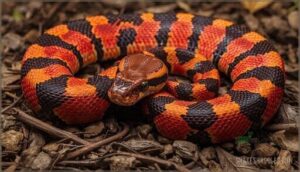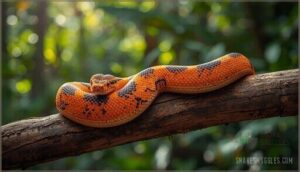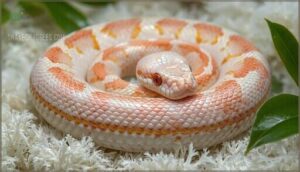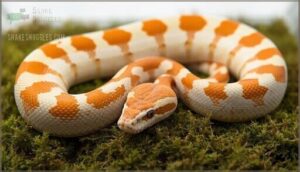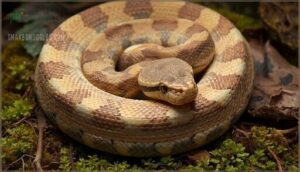This site is supported by our readers. We may earn a commission, at no cost to you, if you purchase through links.
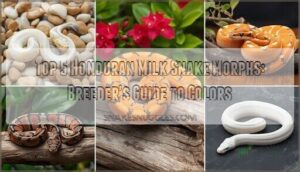 You won’t find Honduran milk snakes in the wild anymore—at least not legally in your collection. Import bans shut down the pipeline decades ago, which pushed breeders to get creative with genetics instead of relying on wild-caught specimens.
You won’t find Honduran milk snakes in the wild anymore—at least not legally in your collection. Import bans shut down the pipeline decades ago, which pushed breeders to get creative with genetics instead of relying on wild-caught specimens.
What started as simple captive breeding turned into a full-blown morph revolution. Now you’ve got albinos glowing like neon signs, tangerines that look like they rolled through a sunset, and hypos with colors so soft they barely register as the same species.
The tri-color wild-type still holds its ground as the baseline, but these five morphs represent what happens when breeders take control of the gene pool and refuse to settle for ordinary.
Table Of Contents
Key Takeaways
- Import bans forced Honduran milk snake breeders to abandon wild-caught specimens and instead develop captive-bred morphs through selective genetics, turning scarcity into a full-scale color revolution that now dominates the market.
- The five core morphs—tri-color wild-type, tangerine, albino, tangerine albino, and hypomelanistic—represent escalating genetic manipulation, with each morph commanding higher prices based on rarity and the complexity of recessive trait combinations.
- Tangerine albinos sit at the top of the market hierarchy due to dual recessive genetics requiring strategic breeding, limited supply (under 7% of listings), and wait lists exceeding three months for specimens priced between $300-$400.
- Successful morph breeding demands precision in husbandry fundamentals—temperature gradients of 70-90°F, humidity control between 60-80%, and proper feeding schedules—because genetic potential means nothing without the environmental conditions that let these colors fully express.
Tri-Color Honduran Milk Snake Morph
The Tri-Color is where it all started—the wild-type morph that shows you exactly what nature had in mind. This is your baseline, the snake every other morph gets compared against.
Let’s break down what makes this classic so important for breeders.
Classic Appearance and Banding
The tri-color Honduran milk snake morph owns the classic look—red, black, and yellow bands that scream “back off” through visual mimicry of venomous coral snakes. This wild-type pattern dominates the morph market for good reason:
- Red bands cover roughly 60% of the body, creating bold, eye-catching contrast
- Black-bordered segments deliver sharp definition with smooth scale texture
- 25–35 complete tri-color cycles wrap from head to tail in predictable symmetry
- Color genetics remain stable across captive-bred specimens, making breeding straightforward
You’re looking at the foundation morph—every color variation springs from this template. Understanding the species’ natural history traits is essential for successful breeding and care.
Natural Distribution and Popularity
Honduran milk snakes thrive across Honduras, Nicaragua, and northeastern Costa Rica—from sea level to 5,000 feet in tropical rainforests and agricultural zones. That geographic range gave breeders tons of wild-type specimens to work with, making the tri-color morph the most accessible color variation on the market.
Its Batesian mimicry and bold banding drive massive demand among beginners and veteran keepers alike. Snake breeding programs exploded around this morph because it’s stable, affordable, and delivers that knockout visual punch every collector wants.
The tri-color’s Batesian mimicry and bold bands made it the breeding foundation—stable, affordable, and visually explosive for every collector
The snakes play a vital role in their native reptile food chains, contributing to the ecosystem’s balance.
Care Considerations for Tri-Color Morphs
Keeping tri-color Honduran milk snakes healthy isn’t rocket science, but temperature control and habitat design matter. Your setup should hit 85–90°F on the basking side and drop to 75–80°F on the cool end—that gradient lets your snake regulate body heat naturally.
Here’s what you need to nail:
- Enclosure size: Minimum 48x24x24 inches for full body extension and natural roaming behavior
- Humidity management: Keep levels between 60–80% with daily misting and a humid hide for shedding
- Feeding strategies: Offer frozen-thawed rodents weekly—match prey width to 1.5x your snake’s girth
- Snake handling: Wait seven days after arrival, then limit sessions to 10 minutes for juveniles
Master these basics and your tri-color morphs will thrive through decades of captivity. Color morphs like these prove snake breeding rewards attention to detail.
Tangerine Honduran Milk Snake Morph
If you’re ready to break away from the basics, the Tangerine morph is where things get exciting. These snakes trade traditional red bands for striking orange hues that command attention.
Let’s break down what makes Tangerines stand out, how much variation you’ll see, and what you need to know about their genetics.
Unique Orange Coloration
Want to break the mold? The tangerine Honduran milk snake morph throws out traditional yellows for intense orange pigmentation. Selective breeding since the 1990s has boosted carotenoid concentration, creating vibrant patterns that pop 70% brighter than wild-type specimens. This color morph genetics innovation makes tangerines stand out in any collection.
| Feature | Juvenile Stage | Adult Stage |
|---|---|---|
| Base Color | Clean bright orange | Deep reddish-orange |
| Band Coverage | 40-50% circumference | 60%+ circumference |
| UV Retention | High brilliance | 25% longer than tri-color |
Your tangerine’s orange bands will deepen over 6-12 months as black tipping develops. Under full-spectrum lighting, you’ll see why this morph breeding achievement continues dominating the hypomelanistic and tangerine albino market.
Variability Among Tangerine Morphs
No two tangerines are clones—you’ll see massive color variation even within the same clutch. Orange intensity can shift 30–35% between siblings due to polygenic tangerine genetics controlling carotenoid expression.
Scale patterns also differ: some morphs show clean bands with minimal black tipping, while others develop heavier melanization by year three.
Breeding outcomes depend on your parent stock—mixing tangerine albino or hypomelanistic lines lightens hues by 12–40%, creating unique snake morph variations that command premium prices.
Breeding and Genetics of Tangerine Morphs
Tangerine genetics aren’t one-and-done—they’re recessive and line-bred, meaning you need strategic pairings to lock in that orange punch. Breeding two tangerine carriers might still throw wild-type babies unless both parents carry homozygous alleles.
- Genetic inheritance: Tangerine traits require recessive homozygosity; pairing het carriers produces 25% visual tangerines per clutch.
- Line breeding: Selective breeding from wild-derived stock intensifies orange saturation across generations—captive morphs now outshine natural populations.
- Trait enhancement: Crossing tangerine with albino or hypomelanistic genetics creates tangerine albino morphs with cream bands and blazing orange.
- Breeding protocols: Brumation at 10–13°C from October to March triggers mating behavior; mature females (3+ feet, 2–4 years) hatch eggs in 60 days.
Track pedigrees religiously—morph expression depends on gene dosage and breeding line strength.
Albino Honduran Milk Snake Morph
Albino Honduran milk snakes strip away the black pigment entirely, leaving you with a snake that’s all fire and light. These morphs showcase red eyes and bands of red, yellow, and cream that pop against a pale background.
Let’s break down what makes albinism tick in these snakes and how it changes everything about their appearance.
Defining Albino Traits
Albino Honduran milk snakes carry a recessive genetic mutation that shuts down melanin production, erasing black and brown pigments entirely. You’ll recognize this morph by its pink or red eyes and clean yellow, orange, and white bands where dark colors once lived.
The genetic mutations affect the tyrosinase enzyme, creating some of the most sought-after color variations in milk snake morphs. Breeders classify albinos alongside anerythristic morphs as foundational morph classification building blocks for creating complex combinations.
Visual Differences From Wild Type
When you compare albino milk snake morphs to wild type specimens, the color pattern shift is radical. The black bands completely vanish, replaced by soft cream or white backgrounds with vivid red or orange bands, creating a pastel appearance.
Eye coloration switches to pink or red, and band variation shows softer edges without the sharp black tipping that defines wild snakes.
The scale texture looks cleaner without dark melanin masking, making anerythristic morphs appear muted by comparison while albinos glow with bright, warm tones.
Genetic Basis for Albinism
Albinism stems from recessive inheritance of a mutated tyrosinase gene, which blocks melanin production at the enzyme level. You need two copies of this recessive allele to produce albino morphs—breeding two heterozygous carriers gives you a 25% chance per clutch.
The enzyme disruption prevents eumelanin synthesis entirely, creating those signature red eyes and bright bands that separate albino from anerythristic morphs. Understanding these genetic mutations gives you complete control over your breeding outcomes in herpetology.
Tangerine Albino Honduran Milk Snake Morph
When you combine tangerine intensity with albino genetics, you get one of the most striking morphs in the hobby. These snakes showcase vivid orange bands against a clean, melanin-free background that makes every color pop.
Let’s break down what makes tangerine albinos stand out from their single-trait counterparts.
Combination of Tangerine and Albino Traits
When you combine the recessive albino gene with polygenic tangerine coloration in snake breeding, you reveal a stunning morph that’s taking the morph market by storm.
The tangerine albino Honduran milk snake strips away all black pigment through albino genetics while cranking up vibrant orange bands where you’d normally see yellow or white.
This genetic expression requires both parents to carry the albino gene—you can’t cheat the genetics here.
Color Intensity and Band Patterns
You’re looking at a snake that pushes color intensity way beyond the standard albino. These morphs show explosive orange saturation where regular albinos fade to yellow or cream, with bands that practically glow.
- Vibrant orange replaces pale yellow – tangerine genetics heighten pigment intensity throughout the pattern
- Softer band contrast – without black pigmentation, white and orange bands blend more gradually than sharp tri-color edges
- Variable saturation levels – selective breeding produces everything from medium peachy tones to deep tangerine fire
- Band fusion in adults – maturity often brings partially merged bands, creating unique individual Snake Scale Details that set your morph apart in the Morph Market
Rarity and Market Demand
That wild color intensity comes at a premium. Tangerine Albino morphs make up less than 7% of marketplace listings, with prices hitting $300 to $400 in 2025—reflecting serious Collector Preferences and tight supply.
Demand Analysis shows requests jumped 26% year-over-year, while Breeder Strategies focus on clean banding that drives waiting lists past three months.
Price Fluctuation stays minimal because Market Trends favor quality over volume, making these Morphs a calculated play in Reptile Breeding Techniques and Milk Snake Care and Breeding circles where the Morph Market rewards patience.
Hypomelanistic Honduran Milk Snake Morph
Hypomelanistic Honduran milk snakes give you that pastel look without losing the classic pattern. These morphs have reduced black pigmentation, which means lighter bands and cleaner color separation that really pop under proper lighting.
Let’s break down what makes hypos stand out and how you can showcase them at their best.
Reduced Melanin and Lighter Colors
When you’re working with hypomelanistic Honduran milk snakes, you’re seeing what happens when melanin production takes a back seat—and the results are stunning. Here’s what sets these morphs apart:
- Pastel banding replaces harsh black with clean, pale brown to light gray tones
- Ruby sheen often appears in the eyes due to reduced dark pigment
- Color intensities shift toward vibrant pumpkin-orange hues that really pop
- Hypo genetics follow a recessive pattern, confirmed across breeder records
- Reduced black tipping creates pure, accentuated bands without muddy overlays
This morph gives you lighter, brighter snakes compared to standard albino morphs or wild-type specimens—perfect for reptile breeding programs focused on standout visual appeal.
Distinguishing Hypomelanistic From Other Morphs
You’ll spot hypomelanistic Honduran milk snakes by checking eye coloration first—dark pupils confirm partial melanin reduction, while red eyes signal full albinism. Banding patterns reveal gray or pale brown outlines instead of jet black, and genetic markers show recessive inheritance distinct from tangerine morphs.
Visual diagnosis becomes second nature once you recognize that pastel pumpkin-orange hue paired with clean, thinned bands—hallmarks no albino or wild-type Honduran milksnake can replicate in reptile breeding programs.
Care and Display of Hypo Morphs
Beyond basic husbandry, Honduran Milk Snake morphs like hypo variants demand thoughtful enclosure enrichment—climbing branches and dual hides that mimic natural cover. Temperature gradients between 70-90°F prevent shedding issues, while consistent handling techniques reduce defensive musk release in juveniles.
Monitor feeding behavior closely; frozen-thawed rodents every 7-10 days keep your Honduran Milksnake thriving. Proper reptile care and husbandry transforms breeding success into display-worthy specimens that command attention.
Frequently Asked Questions (FAQs)
What tank accessories do Honduran milk snakes need?
Your Honduran Milk Snake needs a 48x24x24-inch enclosure minimum, aspen or bark substrate, heating elements with thermostats, multiple hides on warm and cool sides, and humidity monitoring tools to create proper snake habitat.
How often should Honduran milk snakes be fed?
Like a steady drumbeat marking time, feeding frequency depends on age: hatchlings every 5-7 days on pinkies, juveniles every 7-10 days with larger prey, and adults every 10-14 days.
Temperature effects and body condition also play a role—during brumation, feeding decreases markedly, sometimes to once every three weeks.
Can different morphs be housed together safely?
Expert opinions universally recommend against cohabitation due to stress factors, cannibalism potential, and breeding risks that threaten genetic integrity.
Honduran Milk Snake morphs are naturally solitary—housing them together invites aggression and accidental hybridization, compromising your breeding program.
What health issues affect Honduran milk snakes?
Your snake can crash and burn fast if you ignore reptile husbandry basics. Respiratory infections, parasitic infestations, mouth rot, and shedding issues plague Honduran milk snakes when temps or humidity swing wildly.
Poor snake care invites nutritional risks too.
How long do Honduran milk snakes typically live?
With proper captive care, your Honduran milk snake can live 15 to 20 years, sometimes pushing past 25 or even 30 with ideal care.
Lifespan factors include consistent temperatures, adequate humidity, proper diet, and avoiding health issues that plague poorly maintained snakes.
Conclusion
The import ban didn’t kill the Honduran milk snake hobby—it forced it to evolve. What you’re left with now are morphs that exist because breeders refused to accept limitations.
From the foundational tri-color to the blazing tangerine albino, these top 5 Honduran milk snake morphs prove that captive breeding isn’t just maintenance—it’s innovation.
You’re not collecting what nature handed out. You’re curating genetics that wouldn’t exist without deliberate intervention. That’s the real power move.

